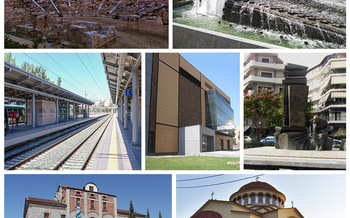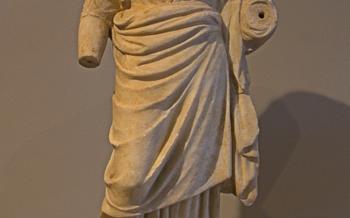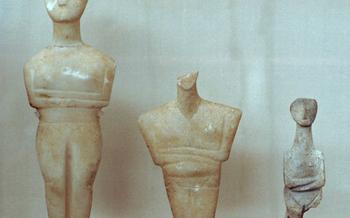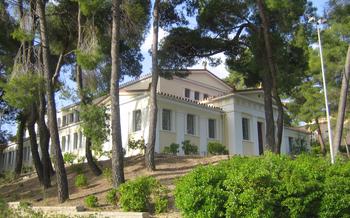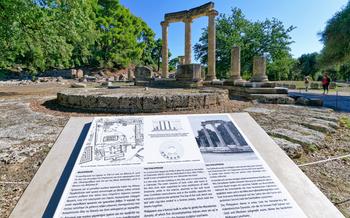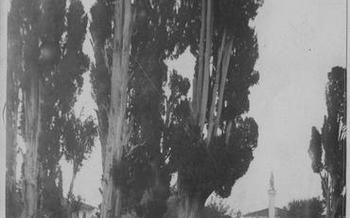
Archaeological Park of Dion
- Dion: Antiquity's City of Zeus
- A Stroll Through History: The Archaeological Park
- Unveiling the Temple of Zeus: A Majestic Legacy
- Echoes of Ancient Theater: Dion's Odeon
- Stepping into the Villas: Opulence and Everyday Life
- Ancient Baths: A Sanctuary of Relaxation and Rituals
- Exploring the Sanctuary of Demeter: Mysteries Unraveled
- Museum of Dion: Unearthing the Past
- Dion's Hippodrome: Chariot Races and Spectacles
- Nature's Embrace: Mount Olympus Views
- Mosaics of Dion: Artful Storytelling
- Dion's Agora: Marketplace and Social Hub
- Festival of Zeus: Reviving Ancient Traditions
- Insider Tip: Explore Beyond the Main Sites
Dion: Antiquity's City of Zeus
In the heart of Pieria, Greece, nestled at the foot of majestic Mount Olympus, lies the ancient city of Dion. Once a thriving metropolis and a sanctuary dedicated to the almighty Zeus, Dion stands today as an archaeological treasure trove, inviting visitors to step back in time and explore the grandeur of antiquity.
Dion's history dates back to the 6th century BC, when it was founded by the Pierian tribe. The city quickly rose to prominence, becoming a religious center and a vital trading hub. Under the patronage of the Macedonian kings, particularly Alexander the Great, Dion flourished, reaching its zenith in the 4th century BC.
The archaeological remains of Dion offer a glimpse into the city's opulent past. Temples, theaters, villas, and public baths stand as testaments to the artistry and engineering prowess of the ancient Greeks. Among these ruins, the majestic Temple of Zeus reigns supreme, its imposing presence evoking the awe and reverence that once filled the hearts of worshippers.
Planning a visit to Dion is a journey into the annals of antiquity. Allow ample time to explore the extensive archaeological park, marvel at the architectural wonders, and immerse yourself in the rich history that permeates every corner of this ancient city.
A Stroll Through History: The Archaeological Park
The Archaeological Park of Dion is a treasure trove of ancient ruins that invite you on a captivating journey through time. As you step into the park, you'll be greeted by a sprawling expanse of excavated remains, each whispering tales of the city's glorious past.
The layout of the park is designed to showcase the key historical periods represented in the ruins. The most prominent structures are the Temple of Zeus, the Odeon theater, and the villas, which offer a glimpse into the religious, cultural, and domestic life of ancient Dion.
A comprehensive visit to the park should start from the Temple of Zeus, the heart of the city's religious life. From there, proceed to the Odeon, where you can imagine the echoes of ancient performances resonating through the theater. The villas, with their intricate mosaics and frescoes, provide an insight into the opulence and everyday life of Dion's elite.
As you wander through the park, take note of the smaller yet significant structures that add to the site's charm. The ancient baths, with their well-preserved hypocaust heating system, offer a glimpse into the bathing rituals of the time. The sanctuary of Demeter, dedicated to the goddess of harvest, reveals the importance of agriculture in Dion's economy.
Don't miss the opportunity to explore the city's fortifications, which once protected Dion's treasures. The massive walls, towers, and gates stand as a testament to the city's strategic importance.
Finally, end your journey at the Museum of Dion, where you can admire artifacts unearthed from the archaeological site. Interactive exhibits and educational resources bring the ancient world to life, providing a deeper understanding of Dion's rich history and culture.
Unveiling the Temple of Zeus: A Majestic Legacy
The Temple of Zeus stands as a testament to the grandeur and devotion of ancient Dion. Built in the 5th century BC, this colossal temple was dedicated to the supreme god of the Greek pantheon, Zeus. Its imposing Doric columns, intricately carved pediments, and majestic staircase evoke a sense of awe and reverence.
Step inside the temple's vast interior, and you'll be greeted by an atmosphere of solemnity and grandeur. The cella, or main chamber, once housed a colossal statue of Zeus, crafted from ivory and gold. Though time has eroded the statue, its sheer size and splendor can still be imagined through the remaining fragments.
Explore the temple's surroundings, and you'll discover a treasure trove of artifacts and remnants that shed light on its religious significance. Altars, votive offerings, and inscriptions provide clues to the rituals and ceremonies that took place within these sacred walls.
In ancient times, the Temple of Zeus was not merely a place of worship; it was also a center of community gatherings, festivals, and religious processions. The annual festival of Zeus, known as the Diaia, attracted pilgrims from across Greece to celebrate the god's benevolence and seek his blessings.
As you stand amidst the ruins of this majestic temple, let your imagination transport you back to a time when gods and mortals walked hand in hand. Feel the spiritual energy that still lingers in the air, and marvel at the enduring legacy of ancient Greece's most powerful deity.
Echoes of Ancient Theater: Dion's Odeon
The Odeon, a smaller theater within the archaeological park, echoes with the whispers of ancient performances and artistic expressions. Constructed in the 2nd century AD, this 500-seat theater served as a venue for musical concerts, theatrical plays, recitals, and public readings. Its well-preserved seating tiers, stage, and orchestra pit offer a glimpse into the world of entertainment in ancient Dion.
The Odeon's intimate atmosphere and excellent acoustics create a captivating setting for performances. Imagine the vibrant melodies of ancient instruments filling the air as talented musicians and actors graced the stage. The theater's design allowed for optimal sound projection, ensuring that every word and note reached the audience.
Today, the Odeon stands as a testament to Dion's rich cultural heritage. It continues to host cultural events, performances, and concerts, allowing visitors to experience the magic of ancient theater in a truly authentic setting. Whether you attend a modern-day performance or simply marvel at its architectural beauty, the Odeon is a must-visit for history buffs and theater enthusiasts alike.
Stepping into the Villas: Opulence and Everyday Life
The villas of Dion, scattered throughout the archaeological park, offer a glimpse into the opulent lifestyles of the city's elite. Adorned with exquisite mosaics and frescoes, these luxurious residences showcase the artistic talents of ancient artisans. The intricate designs depict mythological scenes, landscapes, and everyday activities, providing a vibrant tapestry of life in ancient Dion.
Each villa boasts unique architectural features and styles, reflecting the diverse influences that shaped the city's culture. From elegant peristyle courtyards to grand reception halls, these dwellings exude an aura of sophistication and comfort. The well-preserved mosaics that adorn the floors and walls depict scenes of banquets, hunting expeditions, and mythological tales, offering a glimpse into the pastimes and beliefs of the villa's inhabitants.
Beyond their aesthetic beauty, the villas also provide insights into the daily lives of the ancient Dion's elite. Elaborate kitchens reveal the culinary practices and dietary habits of the time, while private bathing facilities hint at the importance of personal hygiene and well-being. The discovery of imported goods and exotic artifacts further attests to the cosmopolitan nature of Dion and its extensive trade networks.
Stepping into these villas is like stepping back in time, transporting visitors to a world of opulence, artistry, and everyday life in ancient Greece. They stand as testaments to the refined tastes and cultural achievements of Dion's elite, inviting visitors to imagine the lives that unfolded within their walls.
Ancient Baths: A Sanctuary of Relaxation and Rituals
In the heart of Dion's archaeological park, beyond the grand temples and theaters, lies a sanctuary of tranquility and rejuvenation – the ancient baths. These well-preserved structures offer a glimpse into the bathing rituals and practices of ancient Greek society, which held deep cultural and religious significance.
Step into the bath complex, and you'll be greeted by a series of interconnected rooms, each serving a specific purpose. The frigidarium, with its chilly plunge pool, was used for invigorating cold baths. The tepidarium, with its warm, soothing waters, offered a more relaxing experience. And the caldarium, the hottest room, was reserved for intense sweating and cleansing.
The ancient Greeks believed that bathing was not just a hygienic practice but also a sacred ritual. The baths were often associated with religious ceremonies and festivals, where people cleansed themselves both physically and spiritually. The presence of a nearby sanctuary dedicated to the healing god Asclepius further reinforces the connection between bathing and divine favor.
The baths in Dion were not just functional spaces but also architectural marvels. The hypocaust, an ingenious underfloor heating system, ensured a constant supply of warm air, creating a comfortable and luxurious bathing environment. The walls were adorned with intricate mosaics and frescoes, showcasing the artistic prowess of ancient Dion's artisans.
As you explore the ancient baths, imagine yourself stepping back in time, immersing yourself in the soothing waters, and experiencing the same rituals and sensations that the people of Dion enjoyed centuries ago. Let the tranquility of this sacred space wash away your worries and transport you to a world of relaxation and rejuvenation.
Exploring the Sanctuary of Demeter: Mysteries Unraveled
In the heart of the Archaeological Park of Dion, the Sanctuary of Demeter stands as a testament to the ancient Greek reverence for the goddess of harvest and fertility. Built in the 5th century BC, the sanctuary was a sacred site dedicated to Demeter and her daughter Persephone, whose myth played a central role in the Eleusinian Mysteries, a secret religious cult that promised initiates a blessed afterlife.
The sanctuary complex consists of a temple, an altar, and a stoa, or covered walkway. The temple, adorned with Doric columns and intricate sculptures, housed a colossal statue of Demeter, crafted from Parian marble. Archaeologists have unearthed numerous artifacts within the sanctuary, including votive offerings, pottery, and inscriptions, shedding light on the rituals and beliefs associated with Demeter's cult.
Visitors to the sanctuary can immerse themselves in the sacred atmosphere of this ancient site, contemplating the stories and mysteries that unfolded here. The sanctuary's evocative ruins offer a glimpse into the spiritual beliefs and practices of the ancient Greeks, connecting us to a rich cultural heritage that continues to fascinate and inspire.
Museum of Dion: Unearthing the Past
Situated within the archaeological park, the Museum of Dion stands as a treasure trove of artifacts unearthed from the ancient city. Its collection offers a captivating journey through Dion's rich history and culture. As you step inside, you'll be greeted by a diverse array of exhibits, including sculptures, pottery, jewelry, coins, and inscriptions. Each artifact tells a story, providing glimpses into the lives, beliefs, and artistry of Dion's inhabitants.
One of the highlights of the museum is the Dion Head, a magnificent marble sculpture dating back to the 4th century BC. This life-sized head, possibly depicting Alexander the Great, showcases the exceptional skill and artistry of ancient Greek sculptors. Its serene expression and intricate details leave visitors in awe.
Another must-see exhibit is the mosaic floor from the Villa of Dionysus. With its vibrant colors and intricate designs, this mosaic depicts scenes from Greek mythology, including the birth of Dionysus, the god of wine. The vivid portrayal of figures, landscapes, and mythological creatures offers a glimpse into the artistic traditions and storytelling of the ancient world.
The museum also houses a collection of bronze and ceramic figurines, offering insights into the religious practices and beliefs of Dion's people. These figurines depict various deities, heroes, and mythical creatures, providing a tangible connection to the spiritual world of ancient Greece.
A visit to the Museum of Dion is an essential complement to your exploration of the archaeological park. It allows you to delve deeper into the history and culture of this ancient city, bringing its stories and traditions to life.
Dion's Hippodrome: Chariot Races and Spectacles
In the heart of the Archaeological Park of Dion, where history reverberates, stands an impressive testament to ancient sporting prowess—the hippodrome. This elongated, rectangular arena, stretching over 300 meters in length, once hosted exhilarating chariot races, equestrian contests, and other thrilling spectacles that captivated the city's inhabitants.
The hippodrome's design mirrored that of its counterparts in other ancient Greek cities, featuring a central track flanked by spectator stands. The seating arrangements allowed spectators to relish the excitement from various vantage points, immersing themselves in the electrifying atmosphere.
Chariot races, a beloved pastime in ancient Greece, took center stage at the Dion hippodrome. Skilled charioteers, known as auriga, competed fiercely, guiding their horse-drawn chariots around the track in a display of speed, agility, and strategy. The roar of the crowd, the thunder of hooves, and the dust swirling in the air created an unforgettable spectacle.
Beyond chariot races, the hippodrome also hosted a variety of other events, including equestrian competitions, athletic contests, and theatrical performances. These events showcased the prowess of athletes, the grace of horses, and the talents of performers, providing entertainment and amusement to the citizens of Dion.
Today, visitors can wander through the remnants of this ancient sporting venue, imagining the vibrant atmosphere and the cheers of the spectators. The hippodrome stands as a testament to the diverse and lively entertainment that enriched the lives of the people of Dion centuries ago.
Nature's Embrace: Mount Olympus Views
As you wander through the archaeological park of Dion, your gaze is inevitably drawn to the majestic presence of Mount Olympus, the legendary home of the Greek gods. Towering over the ancient ruins, the mountain's snow-capped peaks create a breathtaking backdrop that enhances the allure of the site.
For outdoor enthusiasts, the park offers a network of hiking trails that lead to various viewpoints, providing panoramic vistas of Mount Olympus and the surrounding landscape. Embark on a leisurely hike, immersing yourself in the tranquility of nature, and capture stunning photographs of the mountain's rugged beauty.
As you stand in awe of Mount Olympus, let your imagination transport you to the realm of Greek mythology. Picture Zeus, the king of the gods, wielding his thunderbolts from his throne atop the mountain, while other deities engage in celestial dramas. The mountain's imposing presence evokes a sense of awe and wonder, reminding us of the enduring power of ancient myths and legends.
Mosaics of Dion: Artful Storytelling
Dion's ancient ruins are adorned with stunning mosaics that captivate visitors with their intricate designs and masterful craftsmanship. These colorful masterpieces, painstakingly created by skilled artisans, depict a wide range of subjects, from mythological scenes to everyday life, offering a glimpse into the artistic and cultural heritage of ancient Greece.
The mosaics, composed of small, colored tiles called tesserae, showcase the exceptional talent and precision of their creators. The intricate patterns and lifelike representations of human figures, animals, and landscapes reveal the deep artistic sensibilities of the ancient Greeks.
One of the most remarkable mosaics is located in the House of Dionysus, depicting the god of wine and revelry surrounded by his followers. The mosaic's vibrant colors and dynamic composition bring the scene to life, capturing the essence of Dionysian celebrations.
Another notable mosaic adorns the floor of the Odeon theater, showcasing a mesmerizing depiction of the sea god Oceanus and his wife Tethys. The mosaic's swirling waves and intricate details create a sense of movement and depth, transporting viewers to the realm of ancient mythology.
These mosaics not only served as decorative elements but also held symbolic and narrative significance. They conveyed stories, myths, and messages, providing valuable insights into the beliefs, values, and cultural practices of ancient Dion.
Exploring the mosaics of Dion is a journey through time, allowing visitors to admire the artistry, craftsmanship, and storytelling prowess of the ancient Greeks. These intricate masterpieces offer a glimpse into the vibrant world of ancient Dion and continue to inspire and captivate visitors to this day.
Dion's Agora: Marketplace and Social Hub
The agora served as the bustling heart of ancient Dion, a vibrant hub where commerce, social interactions, and political discourse converged. Imagine a lively marketplace filled with stalls selling an array of goods, from fresh produce to handcrafted pottery and textiles. The air buzzed with the sounds of bargaining, haggling, and the cheerful banter of locals going about their daily business.
Beyond its commercial function, the agora held immense social and political significance. It was the place where citizens gathered for public assemblies, debated important issues, and made decisions that shaped the city's future. Philosophical discussions, political rallies, and theatrical performances often took place in this central square, fostering a sense of community and civic engagement.
The layout of the agora reflected its multifaceted role. Surrounding the open marketplace were various structures serving different purposes. Temples dedicated to patron deities, administrative buildings, and meeting halls lined the perimeter, creating a harmonious architectural ensemble.
Market days were particularly lively events, drawing people from neighboring towns and villages to Dion. Farmers brought their harvests to sell, merchants displayed their wares, and artisans showcased their skills. The agora transformed into a vibrant tapestry of colors, sounds, and aromas, a testament to the economic and social vitality of ancient Dion.
Festival of Zeus: Reviving Ancient Traditions
Dion's rich history and cultural heritage are brought to life during the annual Festival of Zeus, a vibrant celebration that transports visitors back in time. This immersive event invites you to experience the ancient rituals, ceremonies, and traditions that once filled the streets of Dion.
As the festival unfolds, the archaeological park transforms into a stage for reenactments of ancient customs. Watch in awe as costumed performers recreate religious ceremonies, processions, and sacrifices, honoring the mighty god Zeus and other deities.
The festival is not just about historical reenactments; it's also a celebration of Greek culture and heritage. Enjoy traditional music and dance performances, participate in workshops on ancient crafts and customs, and savor delicious local cuisine inspired by ancient recipes.
The Festival of Zeus is a unique opportunity to immerse yourself in the spirit of ancient Greece and experience the vibrant culture that once thrived in Dion. Don't miss this chance to step into the past and witness the grandeur of ancient traditions brought to life.
Insider Tip: Explore Beyond the Main Sites
Venture beyond the main attractions of the Archaeological Park of Dion to discover hidden gems and lesser-known areas that offer a unique perspective on this ancient city. Explore the tranquil corners of the park, where you can escape the crowds and find spots for relaxation and reflection amidst the ruins. Follow off-the-beaten-path trails that lead to secluded spots, offering a chance to connect with the park's natural beauty and rich history. Embrace the opportunity to uncover the unique charm and secrets of Dion, creating a truly immersive and unforgettable experience.
